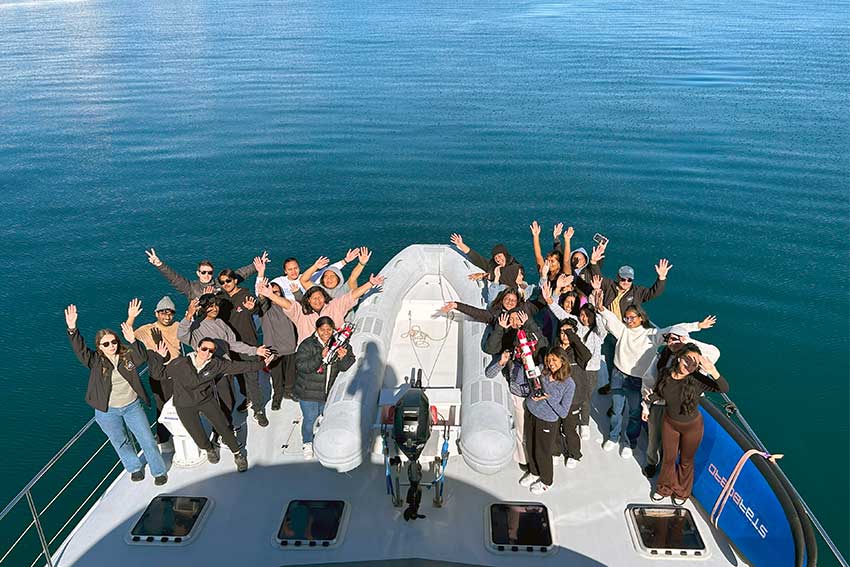Aorere students study ocean with AUT

Data collected by Aorere College students will become part of a longitudinal study of the Mahurangi Harbour marine environment.
With AUT marine scientists Dr Becs Jarvis, Dr Marta Ribó and Associate Professor Kay Vopel, 23 biology students from the south Auckland school used cutting-edge marine research gear in the north Auckland harbour and Tīkapa Moana the Hauraki Gulf.
In May, the Year 13 students collected data at 11 different locations to record how oceanographic parameters change from the estuary, where freshwater from land meets the salt water of our marine environment, and out to sea.
At each location, students measured salinity, temperature, dissolved oxygen, turbidity (cloudiness of the water) and photosynthetically active radiation (light transmission through the seawater).
Aorere student Stephanie Ngungutau said the opportunity to collect scientific data alongside AUT researchers was something she would recommend to anyone, describing the trip as “a fun, informative and amazing experience.”
Student Nazanin Qasemi said: "It was genuinely one of the best trips I’ve ever gone to from school. We learnt so much about the sea whilst still having heaps of fun with our friends.”
Back at AUT’s School of Science, Dr Jarvis and Dr Ribó will help the students analyse the data collected.
The results will add to the scientific record and be shared with students’ whānau and community to help gain a better understanding of how marine science research can help mitigate the impacts of climate change and human activity on the marine environment.
Funding from the Curious Minds South Auckland Participatory Science Platform (supported by Te Hononga Akoranga COMET) made it possible for AUT to take the college students out on a boat to conduct research, Dr Jarvis says.
“We hope that by giving these students the opportunity to get hands-on experience doing marine research, they can see themselves as scientists already, and that this opportunity will help make university and career pathways in science more visible,” she says.
“This is why we’re working with Aorere College - to give students what we hope will be an interesting and valuable experience that shows them where science can take them.”
STEM manager at Te Hononga Akoranga COMET, Ying Yang, says south Auckland rangatahi have huge potential in the sciences, but pathways are not always visible to them.
“Curious Minds projects enable students to experience science in relevant, exciting ways.
“AUT has been fantastic in facilitating this incredible hands-on opportunity for students and teachers. I’m looking forward to seeing how the students interpret and communicate the data,” Ying says.
“This initiative is a great way to empower students to be the leaders of their own learning while simultaneously growing science awareness.”
About AUT’s Faculty of Health and Environmental Sciences - Te Ara Hauora A Pūtaiao
AUT’s largest faculty offers an extensive range study programmes and a diverse, rich research profile that spans across the disciplines of health, sport and science. The School of Science sits within the Faculty and offers a diverse range of subjects including environmental and marine science.
About Aorere College
Aorere College is a co-educational school in Papatoetoe, Auckland. With a roll of close to 1400 students, the school works closely with whānau and the community to grow high-achieving young people with the character, confidence and qualifications for future success.
About Curious Minds South Auckland
The Curious Minds South Auckland Participatory Science Platform is an initiative of the Ministry for Business, Innovation and Employment’s A Nation of Curious Minds Strategy. It is managed by Te Hononga Akoranga COMET, an independent charitable trust based in Auckland. Its mission is to work with communities to close educational gaps and create more effective, equitable learning pathways for all.
About MBIE’s Curious Minds – He Whenua Hihiri i te Mahara participatory science platform
Part of the Ministry for Business, Innovation and Employment’s Curious Minds programme, the Participatory Science Platform was created in 2015 to support collaborative, community projects that bring together communities, science and technology to investigate locally important research questions and problems.